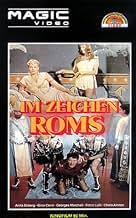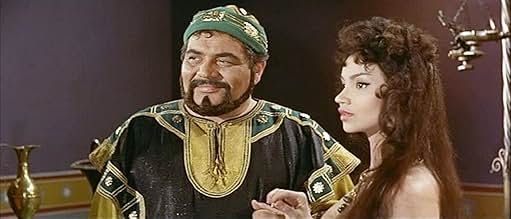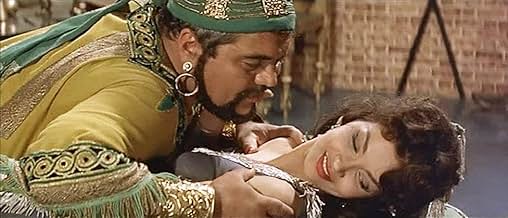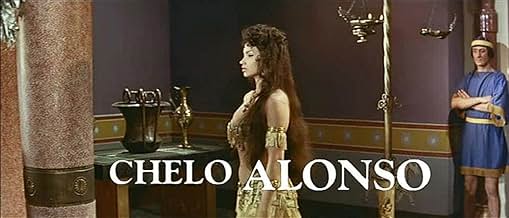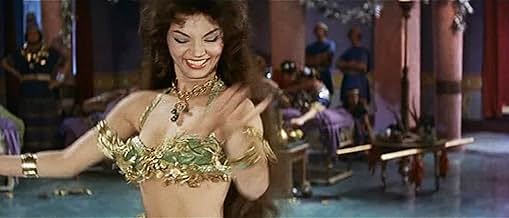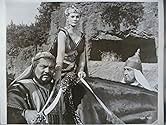Zenobia, Queen of Palmyra, revolts against Rome and defeats the Roman troops - but she makes a big mistake when she falls in love with enemy officer Marco Valerio.Zenobia, Queen of Palmyra, revolts against Rome and defeats the Roman troops - but she makes a big mistake when she falls in love with enemy officer Marco Valerio.Zenobia, Queen of Palmyra, revolts against Rome and defeats the Roman troops - but she makes a big mistake when she falls in love with enemy officer Marco Valerio.
Relja Basic
- Un soldato
- (uncredited)
Angelo Casadei
- Il generale
- (uncredited)
Aristide Catoni
- Un senatore
- (uncredited)
Arturo Dominici
- Un ufficiale di Zenobia
- (uncredited)
Featured reviews
Many legends surround Zenobia ancestry ; she was probably not a commoner and she married the ruler of the city, Odaenathus. Her husband became king in 260, elevating Palmyra to supreme power in the Near East by defeating the Sassanians and stabilizing the Roman East. After Odaenathus' assassination, Zenobia became the regent of her son Vaballathus and held de facto power throughout his reign. In 270, Zenobia launched an invasion that brought most of the Roman East under her sway and culminated with the annexation of Egypt. By mid-271 her realm extended from Ancyra, central Anatolia, to southern Egypt, although she remained nominally subordinate to Rome. However, in reaction to the campaign of the Roman emperor Aurelian in 272, Zenobia declared her son emperor and assumed the title of empress (declaring Palmyra's secession from Rome). Then there happens revolts against Rome and she defeats the Roman troops. But Zenobia (Anita Ekberg) makes a big mistake when she falls in love with enemy officer Marcus Valerius (George Marchal) . Forced into slavery and tortured , Marcus manages to getaway , and come to the presence of the queen, offering her his services. They fall in love, which complicates his task, and his loyalty towards Rome that has sent General Marcello (Alberto Farnese) to defeat her. Marcus will help the Romans to conquer her country , but he will also save her life from a coup led by the treacherous Zemanzius (Folco Lulli).
This Sword-and sandals movie is plenty of adventures , emotions, thrills , sword-play , impressive battles, atmospheric settings , powerful score by prolific Angelo Francesco Lavagnino and colorful scenarios well photographed by Luciano Trasatti , shot mostly on location in Zagreb, Croatia. In Nel segno di Roma (1959) stands out a stunning main and support cast with plenty of notorious Italian actors. The motion picture was professionally directed by Guido Brignone assisted by Riccardo Freda and Michelangelo Antonioni , though it has a lot of flaws and gaps.
If the picture hasn't historical perspective , the historical events about this known are the following ones : Zenobia was a cultured monarch and fostered an intellectual environment in her court, which was open to scholars and philosophers. She was tolerant toward her subjects and protected religious minorities. The queen maintained a stable administration which governed a multicultural multiethnic empire. Zenobia married Odenato , around 266 had a common son, Lucius Iulius Aurelius Septimius Vaballathus Atenodoro, better known as Vabalato. In 267 her husband and her stepson were murdered, her respective nephew and cousin Meonius was accused, for which Zenobia sentenced him to death. Her son Vabalato was then only one year old, so Zenobia succeeded her husband and ruled Palmyra as regent for the minor. Both were awarded the honorary titles of Augusta and Augusto. After the death of Gallienus in 268 and seeing that her successor, Claudius the Gothic, had to dedicate all his efforts to countering a Gothic invasion, Zenobia revolted at Palmyra and tried to create her own empire. Her stated goal was to protect the Eastern Roman Empire from the Sasanian Empire, for the peace of Rome, however, her efforts significantly increased the power of her throne. Rome, involved in a new period of chaos due to the different successions, left the queen of Palmyra, who was well established in her kingdom, to try to aspire to create a third empire, with the intention of dominating the two empires that flanked her. Zenobia fortified and beautified the city of Palmyra, which then had a population of over 150,000. The walls surrounding the city were said to be 21 kilometers in circumference. It had an avenue guarded by large Corinthian columns over 15 meters high. It was full of beautiful temples, monuments, gardens and public buildings, among them the Temple of the Sun stood out. In Palmyra about two hundred statues could be found on its columns and on the walls of the agora. Zenobia was conquering new territories, increasing the territory of the Empire of Palmyra in memory of her husband and as a legacy to her son. Zenobia made expeditions with her great army and conquered Egypt , Anatolia as far as Ancyra and Chalcedon, and later Syria, Palestine, and Lebanon. In her short-lived empire, Zenobia seized trade routes vital to the Romans. The Emperor Aurelian, who came to the throne in 270, after stabilizing the Danube border, finally decided to launch a military campaign against it. He sent some of his forces into Egypt and the bulk of his army east through Asia Minor. Zenobia had a large army, made up of her archers and cataphracts commanded by two generals, Zabdas and Zabbai. But Aurelian conquered Egypt and sent his forces into Syria. Zenobia was defeated at the battle of Emesa (present-day Homs), and withdrew to Palmyra, where it was besieged by Aurelian in 272. Palmyra had stocked up on food and relied on the strength of her excellent archers, hoping to hold out for months, but thanks Against the Arab chiefs of the desert, whom Zenobia had disdained, Aureliano overcame the resistance of the city. Zenobia and her son escaped from there on a camel with the help of the Sassanids, but were captured on the Euphrates River by Aurelian's horsemen, and ordered to be taken to Rome. Zenobia's short reign over Egypt and the Palmyrene Empire was over. The remaining Palmyrenes who refused to surrender were captured and executed on Aurelian's orders. She battled the Roman Empire , but the Romans were victorious after heavy fighting; the queen was besieged in her capital and captured by Aurelian, who exiled her to Rome, where she spent the remainder of her life. Zenobia died after 274, and many tales have been recorded about her fate. Her rise and fall have inspired historians, artists and novelists, and she is a patriotic symbol in Syria.
This Sword-and sandals movie is plenty of adventures , emotions, thrills , sword-play , impressive battles, atmospheric settings , powerful score by prolific Angelo Francesco Lavagnino and colorful scenarios well photographed by Luciano Trasatti , shot mostly on location in Zagreb, Croatia. In Nel segno di Roma (1959) stands out a stunning main and support cast with plenty of notorious Italian actors. The motion picture was professionally directed by Guido Brignone assisted by Riccardo Freda and Michelangelo Antonioni , though it has a lot of flaws and gaps.
If the picture hasn't historical perspective , the historical events about this known are the following ones : Zenobia was a cultured monarch and fostered an intellectual environment in her court, which was open to scholars and philosophers. She was tolerant toward her subjects and protected religious minorities. The queen maintained a stable administration which governed a multicultural multiethnic empire. Zenobia married Odenato , around 266 had a common son, Lucius Iulius Aurelius Septimius Vaballathus Atenodoro, better known as Vabalato. In 267 her husband and her stepson were murdered, her respective nephew and cousin Meonius was accused, for which Zenobia sentenced him to death. Her son Vabalato was then only one year old, so Zenobia succeeded her husband and ruled Palmyra as regent for the minor. Both were awarded the honorary titles of Augusta and Augusto. After the death of Gallienus in 268 and seeing that her successor, Claudius the Gothic, had to dedicate all his efforts to countering a Gothic invasion, Zenobia revolted at Palmyra and tried to create her own empire. Her stated goal was to protect the Eastern Roman Empire from the Sasanian Empire, for the peace of Rome, however, her efforts significantly increased the power of her throne. Rome, involved in a new period of chaos due to the different successions, left the queen of Palmyra, who was well established in her kingdom, to try to aspire to create a third empire, with the intention of dominating the two empires that flanked her. Zenobia fortified and beautified the city of Palmyra, which then had a population of over 150,000. The walls surrounding the city were said to be 21 kilometers in circumference. It had an avenue guarded by large Corinthian columns over 15 meters high. It was full of beautiful temples, monuments, gardens and public buildings, among them the Temple of the Sun stood out. In Palmyra about two hundred statues could be found on its columns and on the walls of the agora. Zenobia was conquering new territories, increasing the territory of the Empire of Palmyra in memory of her husband and as a legacy to her son. Zenobia made expeditions with her great army and conquered Egypt , Anatolia as far as Ancyra and Chalcedon, and later Syria, Palestine, and Lebanon. In her short-lived empire, Zenobia seized trade routes vital to the Romans. The Emperor Aurelian, who came to the throne in 270, after stabilizing the Danube border, finally decided to launch a military campaign against it. He sent some of his forces into Egypt and the bulk of his army east through Asia Minor. Zenobia had a large army, made up of her archers and cataphracts commanded by two generals, Zabdas and Zabbai. But Aurelian conquered Egypt and sent his forces into Syria. Zenobia was defeated at the battle of Emesa (present-day Homs), and withdrew to Palmyra, where it was besieged by Aurelian in 272. Palmyra had stocked up on food and relied on the strength of her excellent archers, hoping to hold out for months, but thanks Against the Arab chiefs of the desert, whom Zenobia had disdained, Aureliano overcame the resistance of the city. Zenobia and her son escaped from there on a camel with the help of the Sassanids, but were captured on the Euphrates River by Aurelian's horsemen, and ordered to be taken to Rome. Zenobia's short reign over Egypt and the Palmyrene Empire was over. The remaining Palmyrenes who refused to surrender were captured and executed on Aurelian's orders. She battled the Roman Empire , but the Romans were victorious after heavy fighting; the queen was besieged in her capital and captured by Aurelian, who exiled her to Rome, where she spent the remainder of her life. Zenobia died after 274, and many tales have been recorded about her fate. Her rise and fall have inspired historians, artists and novelists, and she is a patriotic symbol in Syria.
Zenobia, Queen of Palmira, revolts against Rome and defeats the Roman troops under the command of the consul Marcus Valerius. However, they fall in love with each other, which complicates not only Marcus Valerius' tasks, but also his loyalty towards Rome. He will have to find a way to help the Romans conquer Zenobia's territory while protecting her at the same time. But Zenobia's treacherous minister, Semantio, has other plans - he covertly plots against Zenobia by forming an alliance with King Shapur of Persia. With Rome on one side and Persia waiting in the wings, Valerio tries to halt the destruction of Palmira and the possible execution of Queen Zenobia.
This talky, but nicely produced and lavishly decorated peplum film is light on action, but heavy on intrigue, treachery, romance and subterfuge and borders into being a soap opera. It ends with a battle between two armies, soldiers set on fire by catapult- its short but exciting. George Marchal stars as the Roman consul who falls for Anita Ekberg ( who blames the poor sod?!) and Anita Ekberg acts well and fills her costumes well. Chelo Alonso does her usual hip-shaking dance moves.
This talky, but nicely produced and lavishly decorated peplum film is light on action, but heavy on intrigue, treachery, romance and subterfuge and borders into being a soap opera. It ends with a battle between two armies, soldiers set on fire by catapult- its short but exciting. George Marchal stars as the Roman consul who falls for Anita Ekberg ( who blames the poor sod?!) and Anita Ekberg acts well and fills her costumes well. Chelo Alonso does her usual hip-shaking dance moves.
I believe it is. Even reduced in it's intended length, the film has a number of curious elements to make it worth while even today. It was one of the first great productions from the "peplum" film industry, in this case in association with German, French, and Jugoslav studios. The army action relied entirely on men and horses, and also the war machines and traps that are here quiet realistic - catapults and multi-spear throwers, mainly (Stalin Organs, avant la lettre). Then, for arty fans, this is a good way to see where did Michelangelo Antonioni start perfecting his interior shots of dialogue; if you watch the German video copy (one of the best colors and editing around) without knowing the language (as I did), you'll notice that the interior shots are never boring - although you get to see some very poor "Egyptian" wall paintings... Finally, the two most prominent topics for most male viewers: Anita Ekberg riding a horse in mini-skirt, wearing daring low-cut evening dresses, and getting her man with a kiss, and a vengeful spear; Chelo Alonso proving in 4 minutes (longer, in the original version) how to be the focus of attention of the film industry with just one choreography... She mixes hand movements from Indian dance, with minimalist ballet and Turkish belly-dance to a perfection; she was famous as a dancer when discovered by film-makers, and with good reason.
Only ruins remain of Palmyra today, but it was once one of the greatest cities in the east dominating the eastern part of the Roman empire from Ancyra down to Egypt. Zenobia was always the object of myths and legends, she was not stupid but highly cultivated, and Palmyra was second only to Alexandria for culture and civilisation. However, Rome would not allow it but had to swallow it all down in its own imperial preponderance and bring Zenobia a prisoner to Rome. There she was apparently granted some freedom and worthy sustenance unto her dying day. The film makes a romance out of it, making a Roman soldier a prisoner in Palmyra, whom Queen Zenobia falls in love with, thus complicating both the lives of herself and her Roman lover. Eventually they find each other in peace at Rome. The film is a monumental typical Peplum feature with very much pomp and circumstance and a great battle in the end. The music tries to equal the pompous ostentation without succeeding. It is no more than a superficial entertainment with Anita Ekberg at the centre of it with plenty of space for the admiration of her beauty, but she was never a great actress. Her best performances were in totally different genres.
Sign of the Gladiator was the first Italian epic to be released by American International Pictures. In 1959 their co-founders James H. Nicholson and Samuel Z. Arkoff took careful note how arch rival Joe Levine had purchased the Steve Reeves epic Hercules for just 100,000 dollars and then made millions. So, Jim and Sam picked up another Reeves winner, Goliath and the Barbarians, plus what was to become their first Italian offering, At the Sign of Rome.
Although this one doesn't have a man with a big chest, it makes up for it with a woman of similar attributes. Anita Ekberg plays the Queen of the desert, Xenobia (spelled with an "X" in the AIP credits), and the Italian costume designers were clearly under orders to ensure that her 40-inch bosom receives maximum uncoverage. The off-the-shoulder black evening gown that she seductively wears when arraigned before the Roman Senate could well be the same dress she wore in La Dolce Vita, made the same year. For younger viewers there is plenty of action and sword play, and the battle scenes were possibly one of the first occasions that stunt men allowed themselves to be set on fire. The hero suffers a spear straight to the chest, but in true western style he's as right as rain a few scenes later.
AIP decided that Sign of the Gladiator would make a more exciting title than At the Sign of Rome, even though there wasn't a single gladiator in sight. This difficulty was solved by re-writing the opening narration in which we are told that officers and generals of the Roman army were often recruited from the ranks of gladiators and that the foremost of the ex-gladiators was chosen to lead the army against Xenobia's hordes. Unfortunately, anyone who misses the opening narration will be waiting 85 minutes for a gladiator who never shows up. New York-based Titra Sound, regarded as the best dubbing company of all time, supply the English narration and dialogue, spoken by legendary voice actors George Gonneau, Peggy Lobbin and Norman Rose.
For the music score AIP would frequently bring in Les Baxter to entirely re-score the film from beginning to end. However, for Sign of the Gladiator AIP retained the original score by Lavagnino, except for the opening and closing titles which were re-shot with fresh footage. For the main title we see a scantily-clad showgirl dancing round a flaming altar, accompanied by Lavagnino's eerie music from the scene where the hero is tortured by thirst in the desert. To accompany the end title AIP made the bold (though hardly artistic) decision to finish with a pop song. "Xenobia" was composed by future film music giant Dominic Frontiere, with lyrics by Milton Raskin. The vocalist was the dependable Bill Lee who the previous year was chosen to dub the singing voice of John Kerr in South Pacific. American International Records released "Xenobia" as a single (AIR 501), but by way of an in-house joke named the backing group as the "Al Simms Sextet." (Simms was a senior executive at AIP and in charge of the music department). Milton Raskin had an unenviable task in devising pop lyrics for an Italian epic, but this is what he came up with: "Xenobia, lovely as the night / Eyes of misty light / Holding me close to you / Xenobia, lips of flame and fire / Burning with desire / More than I ever knew / Xenobia, hear me call to you from afar / I will go wherever you are / Will you open your heart? / For this I know – I am yours if you will command / Take my arm and you'll understand / What I knew from the start / Xenobia, do you lead me on? / Will my dream be gone? / Will it fade in the blue above? / Be mine alone, Xenobia, my love ."
This film may have started out as a serious historical exercise, but by the time Miss Ekberg and AIP had finished, it was a fun entertainment movie for all the family .and highly enjoyable. More importantly, the release made a healthy profit for AIP who were then able to buy up over 50 other Italian epics, many of them going straight to another company venture -- American International Television.
Although this one doesn't have a man with a big chest, it makes up for it with a woman of similar attributes. Anita Ekberg plays the Queen of the desert, Xenobia (spelled with an "X" in the AIP credits), and the Italian costume designers were clearly under orders to ensure that her 40-inch bosom receives maximum uncoverage. The off-the-shoulder black evening gown that she seductively wears when arraigned before the Roman Senate could well be the same dress she wore in La Dolce Vita, made the same year. For younger viewers there is plenty of action and sword play, and the battle scenes were possibly one of the first occasions that stunt men allowed themselves to be set on fire. The hero suffers a spear straight to the chest, but in true western style he's as right as rain a few scenes later.
AIP decided that Sign of the Gladiator would make a more exciting title than At the Sign of Rome, even though there wasn't a single gladiator in sight. This difficulty was solved by re-writing the opening narration in which we are told that officers and generals of the Roman army were often recruited from the ranks of gladiators and that the foremost of the ex-gladiators was chosen to lead the army against Xenobia's hordes. Unfortunately, anyone who misses the opening narration will be waiting 85 minutes for a gladiator who never shows up. New York-based Titra Sound, regarded as the best dubbing company of all time, supply the English narration and dialogue, spoken by legendary voice actors George Gonneau, Peggy Lobbin and Norman Rose.
For the music score AIP would frequently bring in Les Baxter to entirely re-score the film from beginning to end. However, for Sign of the Gladiator AIP retained the original score by Lavagnino, except for the opening and closing titles which were re-shot with fresh footage. For the main title we see a scantily-clad showgirl dancing round a flaming altar, accompanied by Lavagnino's eerie music from the scene where the hero is tortured by thirst in the desert. To accompany the end title AIP made the bold (though hardly artistic) decision to finish with a pop song. "Xenobia" was composed by future film music giant Dominic Frontiere, with lyrics by Milton Raskin. The vocalist was the dependable Bill Lee who the previous year was chosen to dub the singing voice of John Kerr in South Pacific. American International Records released "Xenobia" as a single (AIR 501), but by way of an in-house joke named the backing group as the "Al Simms Sextet." (Simms was a senior executive at AIP and in charge of the music department). Milton Raskin had an unenviable task in devising pop lyrics for an Italian epic, but this is what he came up with: "Xenobia, lovely as the night / Eyes of misty light / Holding me close to you / Xenobia, lips of flame and fire / Burning with desire / More than I ever knew / Xenobia, hear me call to you from afar / I will go wherever you are / Will you open your heart? / For this I know – I am yours if you will command / Take my arm and you'll understand / What I knew from the start / Xenobia, do you lead me on? / Will my dream be gone? / Will it fade in the blue above? / Be mine alone, Xenobia, my love ."
This film may have started out as a serious historical exercise, but by the time Miss Ekberg and AIP had finished, it was a fun entertainment movie for all the family .and highly enjoyable. More importantly, the release made a healthy profit for AIP who were then able to buy up over 50 other Italian epics, many of them going straight to another company venture -- American International Television.
Storyline
Did you know
- TriviaOfficials at the American distributor, American-International Pictures, decided that "Sign of the Gladiator" was a more exciting title than "Sign of Rome," even though there are no gladiators in the film. They simply had one of the characters make reference to "gladiator" in a line of the dubbed dialog,
- GoofsIn the desert scenes there are often agaves which were introduced from the Americas only after 1500.
- Quotes
Zenobia, Queen of Palmira: If you have lied, the tigers at the temple will have a rich repast.
Marcus Valerius, Roman Consul: Your tigers will have to wait in vain.
- ConnectionsFeatured in Kolossal - i magnifici Macisti (1977)
- SoundtracksXenobia
(end title song, US dubbed version)
(1959)
Music by Dominic Frontiere
Lyrics by Milton Raskin
Sung by Bill Lee
Played by the Al Simms Sextet
- How long is Sign of the Gladiator?Powered by Alexa
Details
- Release date
- Countries of origin
- Language
- Also known as
- Sheba and the Gladiator
- Filming locations
- Production companies
- See more company credits at IMDbPro
- Runtime1 hour 38 minutes
- Aspect ratio
- 2.35 : 1
Contribute to this page
Suggest an edit or add missing content


